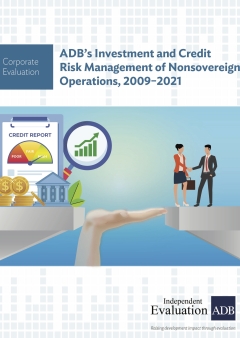
Corporate Evaluation of ADB’s Investment and Credit Risk Management of Nonsovereign Operations (2009–2021)
The leveraging of private sector expertise and funding is becoming increasingly important because of the large amounts of capital required to meet member country objectives such as sustainable growth, poverty alleviation, and climate change mitigation and adaptation. To implement its ambitious plans for private sector participation and growth in member countries, the Asian Development Bank (ADB) must manage investment and credit risks in a timely, robust, and effective way to identify and mitigate risks of its committed nonsovereign portfolio. Risk management and avoidance of undue credit losses is critical for ADB to invest in catalyzing private sector involvement in member countries on a sustainable basis.
Nevertheless, the evaluation found several areas for improvement. ADB does not clearly define the risks that it is willing to take in nonsovereign operations, including under its development mandate. It does not have an agreed set of quantifiable key performance indicators and targets to align incentives, such as return-based targets. It is still in the process of implementing an end-to-end management information system to identify the main processing bottlenecks and provide consolidated information to decisionmakers. Its cost recovery model does not apply the most updated assumptions, and pricing guidelines are not clearly communicated to operations teams in a consolidated document.
